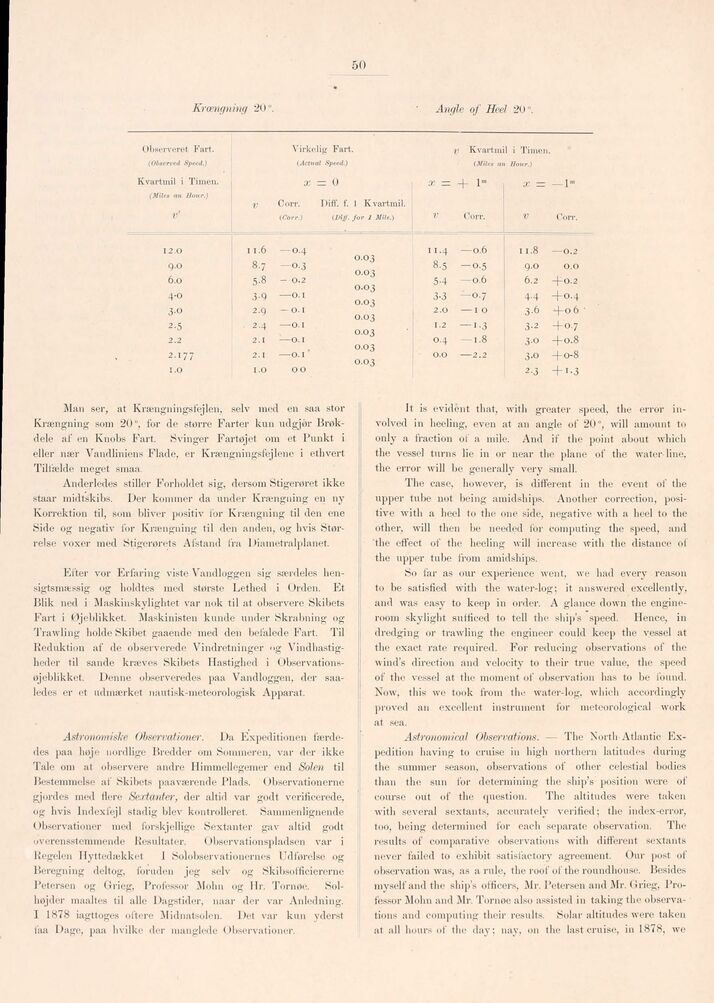
Full resolution (JPEG) - On this page / på denna sida - Sidor ...

<< prev. page << föreg. sida << >> nästa sida >> next page >>
Below is the raw OCR text
from the above scanned image.
Do you see an error? Proofread the page now!
Här nedan syns maskintolkade texten från faksimilbilden ovan.
Ser du något fel? Korrekturläs sidan nu!
This page has never been proofread. / Denna sida har aldrig korrekturlästs.
Krængning 20"
50
Angle of Heel 20
Observeret Fart. (Observed Speed.) Kvartmil i Timen. Virkelig Fart. (Actual Speed.) X = 0 V Kvartmil i Timen. Ißfilee an Hour.) X = + 1" X — — 1"
(Miles an Hour.) 1 V Corr. (Corr.) Diff. f. 1 Kvartmil. (Dijf. Jot 1 Mile.) V Corr. v Corr.
12.0 11.6 — O.4 II.4 —0.6 11.8 — 0.2
q.O S.? —O.3 O.O3 8-5 —0-5 9.0 O.O
6.0 5-8 —-0.2 O.O3 O.O3 5-4 — 0.6 6.2 +0.2
4-0 3-9 —O.I 3-3 —0.7 4.4 +0.4
3-0 2.9 — O.I O.O3 2.0 — I O 3-6 + 06
2-5 2.4 —O.I O.O3 1.2 — 1-3 3-2 + 0.7
2.2 2.1 —O.I O.O3 0-4 — 1.8 30 +0.8
2.177 2.1 — O.I ’ O.O3 0.0 —2.2 3-0 + 0-8
1.0 1.0 00 2-3 + 1-3
Man ser, at Krængningsfejlen, selv med en saa stor
Krængning som 20°, for cle større Farter kun udgjør
Brøkdele af en Knobs Fart. Svinger Fartøjet om et Punkt i
eller nær Vandliniens Flade, er Krængningsfejlene i ethvert
Tilfælde meget smaa.
Anderledes stiller Forholdet sig, dersom Stigerøret ikke
staar midtskibs. Der kommer da under Krængning en ny
Korrektion til, som bliver positiv for Krængning til den ene
Side og negativ for Krængning til den anden, og hvis
Størrelse voxer med Stigerørets Afstand fra Diametralplanet.
Efter vor Erfaring viste Vandloggen sig særdeles
hensigtsmæssig og holdtes med største Lethed i Orden. Et
Blik ned i Maskinskylightet var nok til at observere Skibets
Fart i Øjeblikket. Maskinisten kunde under Skrabning og
Trawling holde Skibet gaaende med den befalede Fart. Til
Reduktion af de observerede Vindretninger og
Vindhastigheder til sande kræves Skibets Hastighed i
Observations-øjeblikket. Denne observeredes paa Vandloggen, der
saaledes er et udmærket nautisk-meteorologisk Apparat.
Astronomiske Observationer. Da Expeditionen
færdedes paa høje nordlige Bredder om Sommeren, var der ikke
Tale om at observere andre Himmellegemer end Solen til
Bestemmelse af Skibets paaværende Plads. Observationerne
gjordes med flere Sextanter, der altid var godt verificerede,
og hvis Indexfejl stadig blev kontrolleret. Sammenlignende
Observationer med forskjellige Sextanter gav altid godt
overensstemmende Resultater. Observationspladsen var i
Regelen Ilyttedækket 1 Solobservationernes Udførelse og
Beregning deltog, foruden jeg selv og Skibsofficiererne
Petersen og Grieg, Professor Mohn og Hr. Tornøe.
Solhøjder maaltes til alle Dagstider, naar der var Anledning.
I 1878 iagttoges oftere Midnatsolen. Det var kun yderst
faa Dage, paa hvilke der manglede Observationer.
It is evident that, with greater speed, the error
involved in heeling, even at an angle of 20°, will amount to
only a fraction of a mile. And if the point about which
the vessel turns lie in or near the plane of the water-line,
the error will be generally very small.
The case, however, is different in the event of the
upper tube not being amidships. Another correction,
positive with a heel to the one side, negative with a heel to the
other, will then be needed for computing the speed, and
the effect of the heeling will increase with the distance of
the upper tube from amidships.
So far as our experience went, we had every reason
to be satisfied with the water-log; it answered excellently,
and was easy to keep in order. A glance down the
engine-room skylight sutficed to tell the. ship’s speed. Hence, in
dredging or trawling the engineer could keep the vessel at
the exact rate required. For reducing observations of the
wind’s direction and velocity to their true value, the speed
of the vessel at the moment of observation has to be found.
Now, this we took from the water-log, which accordingly
proved an excellent instrument for meteorological work
at sea.
Astronomical Observations. — The North-Atlantic
Expedition having to cruise in high northern latitudes during
the summer season, observations of other celestial bodies
than the sun lor determining the ship’s position were of
course out of the question. The altitudes were taken
with several sextants, accurately verified; the index-error,
too, being determined for each separate observation. The
results of comparative observations with different sextants
never failed to exhibit satisfactory agreement. Our post of
observation was, as a rule, the roof of the roundhouse. Besides
myself and the ship’s officers, Mr. Petersen and Mr. Grieg,
Professor Mohn and Mr. Tornøe also assisted in taking the
observations and computing their results. Solar altitudes were taken
at all hours of the day; nay, on the last cruise, in 1878, we
<< prev. page << föreg. sida << >> nästa sida >> next page >>